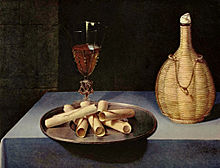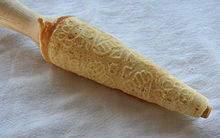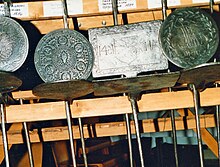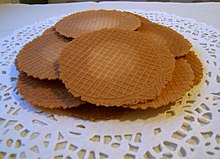Hip (pastry)
Hippen (late Middle High German hipe , originally perhaps "thin pastries") are pastries made from a soft macaroon-like mass ( hip mass ) that is spread very thinly. The hip mass can consist of marzipan , sugar, egg white , flour and milk or cream. The hip mass is seasoned u. a. with vanilla , cinnamon , arrack , lemon or sweet wine . Often there is also flavoring and coloring with cocoa powder . After cooling, the mass will solidify and make a crumbly, crumbly pastry. The recipes are varied, but always contain egg white and sugar. The specialty of the Hippen mass lies in its processing, because after baking it can be shaped (rolled or bent) while hot, because the baked goods only set after they have cooled down.
Typical products are ice cream cones , hip rolls, chimney sweeps , tea cakes and decorations. In the pastry shop, hip paste is also processed into floors, ceilings and decorations. Shaped as baskets, they are used in ice cream parlors for sundae (so-called "ice cream cones") and in the kitchen for desserts. Biscuit and waffle mixes are available filled and unfilled, and they are often dipped in chocolate , fat glaze or couverture .
Manufacturing
- Classic method: The dough is applied in templates to a greased tray and shaped after baking. The baked dough can also be portioned after baking, for example with a cake divider for cake decorations.
- Industrial method: Hippen are made by machine in automatic baking machines, in which liquid dough with a high content of sugar is poured in the form of a ribbon onto a rotating heated baking drum or a baking ring. After the baking process, the hot, flexible dough strip is removed from the baking surface by a scraper and then wound around a rolling mandrel to form a hip in a rolling device. This is then cut to the desired length by means of an automatically triggered knife and is transported via a slide to a conveyor belt located on the side of the machine, which transfers the hips for further processing (chocolate coating system or packaging). Should the hip z. B. are filled with chocolate, the filling takes place during the rolling process through the hollow rolling mandrel. Machines for large-scale industrial production can have a backup ring diameter of over 2 m and up to eight rolling devices with a total capacity of up to 40,000 hips per hour.
- Methods in the household: In the household, specialties are baked according to the classic method, but special waffle irons are also used.
Regional variants
Hippen, also Hohlhippen (common in Austria) or Hüppen , are called Hippengebäck in the specialist literature . Regional are several versions and names such as New Year croissants , New Year cakes , Krüll cake , ( Low German : Rullerkes , Neeijahrskook or Krüllkoken ) terminal cake , Eiserkuchen or beep cake . The first descriptions of wafer rolls date from the 16th century. They were made in the kitchens of some monasteries or the cakes were formed into rolls. There are various special waffle irons for the regional variants that are baked at home .

Hopping
Hüppen are wafer rolls that are made in Switzerland, especially in Thurgau and in and around Zurich . The Hüppen are usually filled with a chocolate mass. The Hüppen are said to have been manufactured for the first time 400 years ago.
New year croissant
The New Year croissants or the New Year cake ( Low German : Rullekes , Neeijahrskook / -kouken or Krüllkoken ) is a sweet pastry that was in northern Germany, especially in the Emsland and East Friesland , traditionally prepared for New Year's Day and eat on New Year's. The New Year's croissant consists of a hard waffle shaped like a croissant (hollow stick) into which whipped cream can be filled. The dough contains cardamom , which is rarely used in desserts, and is baked with special waffle irons and then rolled into a tube over a round piece of wood.
In Emsland and the Grafschaft Bentheim the pastry dough - called New Year's cake here, also Eiserkuchen on the border with Münsterland and New Year's in the Rhineland - is not refined with cardamom, but with cinnamon and liquid vanilla , but also with anise instead of cinnamon. The specialty is often baked throughout the Christmas season.
In Monschau , the Monschauer Dütchen , made according to a similar recipe, have been a specialty since the middle of the 19th century and are now popular with tourists.
Pie cake
In the Münsterland the term piepkuchen is more common. The dough used is almost the same, but the preparation is different. The pastry is rarely rolled after baking, but left in the flat, round shape. Often the ritual "Bake Piepkuchen" is in the foreground, where traditionally the pastries are baked on an open flame with antique waffle irons. When the two waffle irons are pressed together, the dough makes a high-pitched squeaking noise - hence the name.
Clamp cake
The Klemmkuchen is a regional specialty of the Brandenburg and Saxony-Anhalt cuisine in Fläming .
This pastry was brought by the Flemish immigrants who lived in the 12./13. Century after the founding of the Mark Brandenburg by Albrecht the Bear in 1157, the ridge east of the Elbe was populated in high numbers in the east of Germany. Until the 19th century, the customs of the settlers largely determined the cultural identity of the Fläming, which was named after them.
The waffle-like clamp cakes are for larger family celebrations such as baptisms and weddings and especially for today 's Carnival baked in the traditional way in the terminal cake iron over an open flame. While the original dough consisted of rye flour , water, rendered bacon and salt, the ingredients are much more generous today. Butter and sugar are rarely missing from the once flat cakes, which are now often rolled into bags and filled with cream.
Baking the cakes is hard work, because the tongs, which can weigh up to 4 kilograms, have to be pressed together, ie "clamped", during baking. The inside of the flat baking irons is decorated with fine patterns, ornaments and signets, the artistic imprints of which, however, are only visible in traditional flat cakes and are hidden in modern rolled cakes. The ice cream cake, after which the dessert was formerly also known as ice cake , are themselves part of the region's cultural assets - hardly any bride entered marriage without a “joint iron” . The year of manufacture or marriage was often one of the decorations on the inside of the iron.
Around eighty of these irons are on display in the local history museum in Dahme , including the oldest known specimen from 1571. The oldest written tradition of the term iron cake dates back to 1477. Not all of the tongs were made of iron, because the particularly wealthy Flämingians should occasionally have their kitchens adorned with bronze clamps.
Crepe dentelle
Crêpes-dentelles are a traditional Breton long -life pastry specialty . The French wafer rolls are baked very thinly and wrapped tightly in the oven. One variation is the crêpes-dentelles au chocolat noir coated with dark chocolate .
Cigarette russes
For the cigarette russes , a French variant of the rolls, powdered sugar is used as sugar and vanilla is used for flavoring. Cigarette russes are unfilled, but the ends are partly coated with chocolate mass.
literature
- Heinrich Kühne: About old clamps and clamp cakes from Electoral Saxony. in: Sächsische Heimatblätter , issue 6/1981, pp. 261–266
- Helga Tenschert: Angel bread and iron cake, bake with wafers according to old recipes , Munich 1983, ISBN 3-405-12853-6
- Eve Maria Helm: Hasenöhrl and Kirmesfladen , the book of traditional pastries with 278 recipes, Munich 1984, ISBN 3-405-12699-1
- Herbert Stahl : Waffle irons and their use , leaflet 3/3/1 of the Bergisches Museum für Bergbau, Handwerk und Gewerbe , Bergisch Gladbach 1986
- Andreas Eiynck : Pious sayings at the turn of the year - from ice cream cake and cake iron. In: Yearbook of the Emsland Heimatbund. Volume 49/2003, Sögel 2002, pp. 81-102 (with recipes).
Individual evidence
- ↑ "The name hip seems to have been chosen with the thinness of the pastry in mind ... it belongs to ... hip, hip, lean, miserable." , From: hip . In: Jacob Grimm , Wilhelm Grimm : German Dictionary . Hirzel, Leipzig 1854–1961 ( woerterbuchnetz.de , University of Trier).
- ↑ Entry in Duden
- ^ Josef Loderbauer: The confectioner's book in learning fields . Verlag Handwerk und Technik, Hamburg 2009, ISBN 978-3-582-40203-5 .
- ^ IREKS Arkady Institute for Bakery Science (ed.): IREKS ABC of the bakery. 4th edition. Institute for Bakery Science, Kulmbach 1985
- ↑ Information about Hüppen on the website about the culinary heritage of Switzerland, accessed on May 18, 2016
- ↑ Information about Zürcher Hüppen on the website of the City of Zurich, accessed on May 18, 2016
- ↑ Reinhard Anders, Johanna Anders, Christian Henkert, Ronald Kneist: Niederer Fläming Kochbuch - Between Klemmkuchen and Kleinbahn , 1st edition, Agrimedia GmbH, Clenze 2007, ISBN 978-3-86037-331-6 , p. 187
- ↑ Recipe for cigarette russes from Allrecipes Germany, accessed on May 18, 2016
- ^ Recipe for Cigarette Russes at Chefkoch.de, accessed on May 18
Web links
- Hüppen in the database of Culinary Heritage of Switzerland






